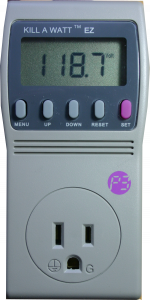 Green Needham Collaborative and NSTAR have donated two Kill-a-Watt EZ meters to the Needham Public Library for loan to library patrons. These handy devices allow you to measure the energy used by the appliances and other electric and electronic devices in your home.
Green Needham Collaborative and NSTAR have donated two Kill-a-Watt EZ meters to the Needham Public Library for loan to library patrons. These handy devices allow you to measure the energy used by the appliances and other electric and electronic devices in your home.
The Kill-a-Watt meters will be loaned out with their instruction manuals. A label on them will have a link to this post where you will find reference material, some additional usage information and tips.
Link to the operating manual (in PDF format)
What you should know before you start:
- The memory in the Kill-a-Watt EZ (unlike earlier models) retains information when you unplug it. So when you first start using it, clear the memory by pressing and holding the RESET key until rESt appears in the display.
- The Kill-a-Watt EZ can translate power usage (measured in kilowatt hours, kWh) into actual cost. If you wish to use this feature, you must tell it the cost of electricity.
- Press and hold the SET key until Rate appears in the display
- As of May, 2010 the prevailing rate for NStar’s residential customers is $0.16 (16 cents per kilowatt hour).
- If the displayed rate is not correct, use the UP and DOWN buttons to set the rate, then press SAVE to save it.
Note: These instructions can be found in the manual under the Quick Start Guide heading.
Using the Kill-a-Watt meter
For purposes of understanding your power usage so that you can save money on energy, you can divide the electric devices in your home into three categories:
- Devices that effectively use power at a constant rate – an incandescent light bulb is one example. You can plug such devices into the Kill-a-Watt, read the instantaneous power usage in Watts and extrapolate the cost based on how many hours a day you use the device.
- Electronic devices – TV’s, game consoles, DVD players, etc. These devices typically use a roughly constant amount of power when operating. However, many also use a significant amount of power when “turned off”. For these devices, you should take a reading when the device is in use and when it is powered off. This can help you determine if you should put some of your electronics on a separate power strip so that all power can be removed from them when not in use.
- Devices that use variable amounts of power – refrigerators and freezers are typical examples, and are often among the biggest energy users in a home. You will want to leave these devices plugged in for several days to get an average reading. The memory and calculation features of the Kill-a-Watt are particularly useful for this type of device as they can extrapolate several days worth of data into a yearly period for you.
If you have questions – or want to share something you’ve learned – please enter a comment on this post.

